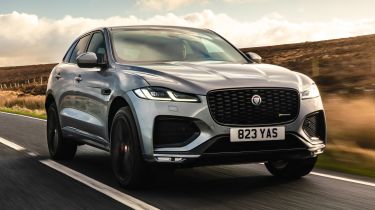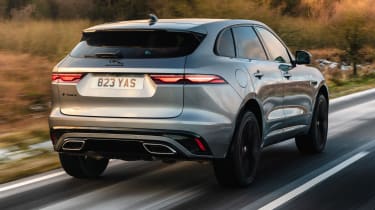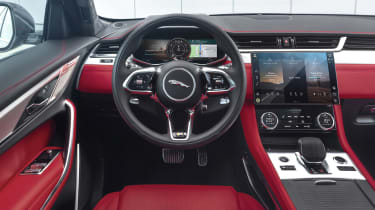New Jaguar F-Pace P400 2021 review
Tech and cabin updates help the Jaguar F-Pace SUV remain competitive with its premium rivals

Verdict
The updates to the F-Pace line-up make it a more appealing prospect than ever before, and it should be on any premium SUV buyer’s shortlist. Sharp handling and strong performance are a given, but it’s now backed up by possibly the best infotainment system in the segment, and a beautifully finished and practical cabin. This P400 model has plenty of driver appeal, but despite the mild-hybrid tech, it remains thirsty.
Jaguar’s first foray into the SUV segment, the F-Pace, is one of its greatest sales success stories. It’s a feat that’s made all the more impressive when you consider that it’s had to compete against a broader and stronger group of rivals than any other model in the firm’s line-up.
Cars such as the Alfa Romeo Stelvio, Audi Q5, BMW X3 and Mercedes GLC all have their own strengths, so the F-Pace has to stay fresh if it’s to carry on fighting with the class-leaders. To that end, Jaguar has treated its SUV to a fairly extensive mid-life makeover.
However, it’s not an update that’s immediately obvious from the outside. At first glance, the F-Pace looks remarkably similar to how it did before. Up front there’s a new grille design and I-Pace-inspired graphics for the LED headlights, while at the back there’s a redesigned set of light graphics. We’re not complaining, though; there was very little wrong with the F-Pace’s handsome shape in the first place.
Used - available now

2023 Ford
Focus
20,134 milesAutomaticPetrol1.0L
Cash £16,495
2023 Toyota
RAV4 Hybrid
14,695 milesAutomaticPetrol2.5L
Cash £27,495
2022 MINI
3-Door Hatch
11,798 milesAutomaticPetrol2.0L
Cash £19,495
2022 Kia
e-Niro
74,997 milesAutomaticElectric
Cash £11,995While the exterior designers haven’t had much to do, the interior team have had a few more late nights. The dashboard design mirrors that of the similarly updated XF saloon, and features new air vents that are slimmer and which flow into horizontal spans of open-pore wood trim and soft leathers. The steering wheel is the same as that found in the revised XE saloon; its new switchgear and smaller centre boss looks much more modern than the old wheel.
The most significant update comes in the form of a huge touchscreen infotainment set-up that sits proud of the dash. The 11.4-inch curved glass display runs Jaguar Land Rover’s latest Pivi Pro operating system. Previously, the F-Pace offered a system that was decent enough, but nothing special. Now, it genuinely has one of the best set-ups on the market.
With the exception of Tesla, it’s hard to think of another manufacturer that offers a display that looks so sharp. Loading times are quick too, most noticeably when switching between navigation views, or when using the 360-degree surround view system.
The interface itself is well thought out and easy to use. The home screen is split into three shortcut tiles for the navigation, phone connectivity, and various media functions, and it’s possible to customise these tiles into different orders and add extra widgets if necessary.
If there’s one criticism we have of Pivi Pro, it’s that it lacks any physical controls like BMW’s iDrive system offers. This is something that some buyers might find more comfortable to use. That aside, Jaguar now boasts what is arguably the best infotainment system in the class.
Fortunately, Jaguar has chosen to keep physical controls elsewhere. While there are some haptic-style switches set into a smooth surface on the dashboard, important functions such as the temperature and fan-speed adjustment are still accessed through big, chunky dials.
There are other detail changes that contribute to the overall step up in cabin quality. The electric window switches have been moved from their former place on the window sills to a more conventional place on the armrests. The skinny front seats in our R-Dynamic SE test car look like they’re lifted straight from the F-Type sports car, but are supremely comfortable.
It’s not just the cabin that has been given a thorough going over – the engine line-up has been overhauled, too. A plug-in hybrid, badged P400e, has been introduced at the top of the range and promises CO2 emissions of 57g/km. Elsewhere, all but the entry-level P250 petrol model gain mild-hybrid technology.
We tried the mild-hybrid set-up aboard the six-cylinder P400 petrol. In theory, it should take the edge off fuel bills, while offering up a subtle electric boost under acceleration. You can rarely feel its effects, though, apart from in heavy traffic, where the stop-start system is keener to operate than in previous non-hybrid F-Pace models. The MHEV system lets the engine spark back into life near-instantaneously, too.
Just don’t get the impression that this 3.0-litre, six-cylinder petrol SUV will now delicately sip fuel simply because it’s had a hybrid badge slapped on it. Officially, this version of the F-Pace will manage 28.8mpg and 221g/km, which means that this definitely isn’t the model to go for if you’re choosing through a company car scheme. On our test route, it seemed like you could just about match that official figure – but only at a gentle motorway cruise.
Any private buyers less interested in saving fuel are in for a treat, though. The P400 has 395bhp and 550Nm just a flex of the right foot away, and it’s more than enough to squeeze you back into those wonderfully supportive seats. The engine is willing to oblige, too: the powertrain is smooth, responsive and makes a warm, tuneful growl when you extend it towards the rev limit. It’s matched to a slick eight-speed automatic box, which responds sharply both when operated through the steering wheel-mounted shift paddles, or just left to its own devices.
Set aside the Porsche Macan, which has a chassis that’s a freak of nature among SUVs, and the F-Pace is right up with the best-driving cars in the class. It manages to run the Alfa Romeo Stelvio very close for agility and sharpness, yet it also feels as rock solid and composed as a BMW X3. The drivetrain sends torque to the rear wheels for the most part, and only directs drive to the front when grip is reduced. This combines with a torque-vectoring system that nips individual brakes to maintain a tighter line through turns and deliver a drive closer to Jag’s four-door saloons.
The experience is helped in no small part by the great control weights. The steering certainly deserves a shout-out: in its sportiest setting it becomes marginally heavier, but it manages to pull off the trick of delivering a consistent, natural response in both modes.
As with the steering, it’s possible to adjust the response of the gearshift, the throttle and the adaptive dampers. While the dynamic suspension setting adds a touch more body control through corners, it remains easily comfortable enough to use as an everyday setting – even on vast 22-inch alloy wheels.
A normal side effect of large wheels and skinny tyres is road noise. However, Jaguar has added an active noise-cancellation system. Should you go for a model with the uprated Meridian sound system, various microphones will detect low-frequency road rumbles and play a note through the speakers of opposing amplitude. This helps to peg back around four decibels of tyre roar inside the cabin, which will reduce fatigue for the occupants. While we didn’t try cars with and without the system back to back, the F-Pace proved to be very hushed at a cruise.
| Model: | Jaguar F-Pace P400 MHEV R-Dynamic SE |
| Price: | £61,115 |
| Engine: | 3.0-litre 6cyl petrol |
| Power/torque: | 395bhp/550Nm |
| Transmission: | Eight-speed automatic, four-wheel drive |
| 0-62mph: | 5.4 seconds |
| Top speed: | 155mph |
| Economy: | 28.8mpg |
| CO2: | 221g/km |
| On sale: | Now |










